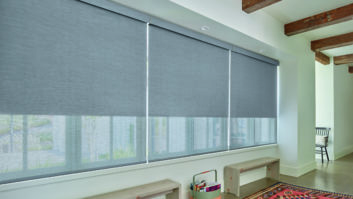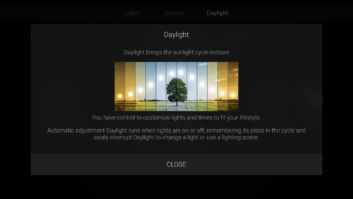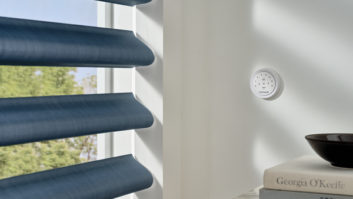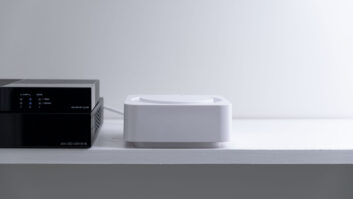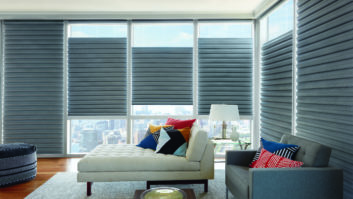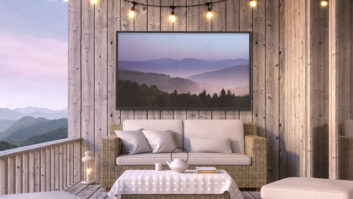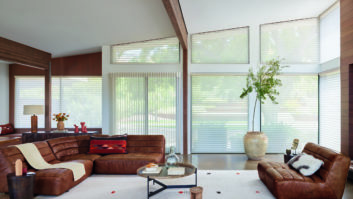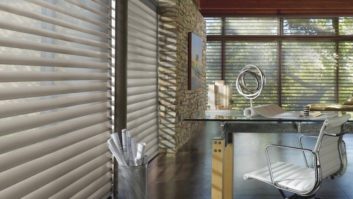Kudos: Across the board improvements with Gen 3; PowerView app simple yet powerful; huge variety of shade styles/options; internal rechargeable battery eliminates clutter at window
Concerns: Charging the internal batteries isn’t as convenient
When it comes to automated shading, the future is bright. Or dim. Whichever you want.
According to recent market research, lighting and shading is booming in the CI channel. A CEDIA Market Analysis anticipates 34 percent growth in the number of projects that will include automated lighting and shading solutions, while another study expects 13 percent growth in the hardwired shade business with 9 percent predicted growth in battery-powered shade installation.
Founded in Germany in 1919, Hunter Douglas has been a dominant force in the window-covering business for many years. The company first introduced its PowerView Automation series in 2015 and really embraced our channel when it launched its Custom Integrator Program (CIP) back in 2019. It’s been nearly two years since my previous review of Hunter Douglas’ PowerView Gen 2 shade system, but the company wasn’t content to stand still and has been hard at work developing the next generation of its motorized platform.
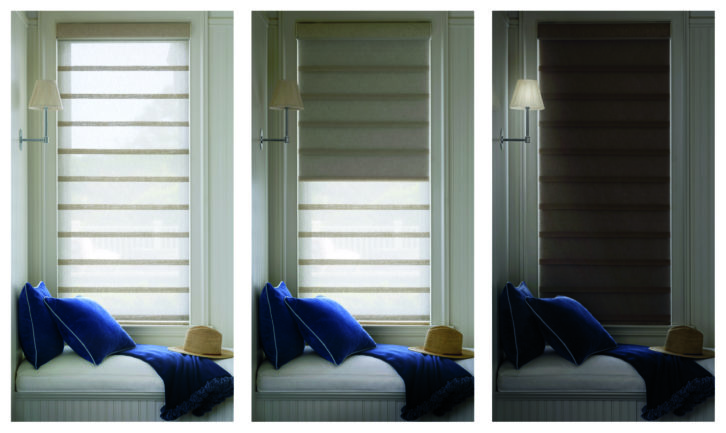
The new PowerView Gen 3 series retains all the fabric options and solutions Hunter Douglas is known for while using a completely new communications technology, new hardware, new power options, and a redesigned, more powerful app for faster, more intuitive setup, installation, and operation.
Dealer Requirements
Joining the Hunter Douglas CIP requires putting a bit of skin in the game with both a financial and time commitment. For new dealers, it’s a $2500 initial investment, which gets the dealer a CIP “Sample Package” that includes all the materials you’ll need to be successful presenting, demonstrating, and selling Hunter Douglas shades. This includes seven massive books filled with hundreds of fabric samples featuring the company’s different styles divided into groups like Silhouette, Pirouette, Duette, etc. It also includes a fully working PowerView Gen 3 kit and shade sample that allows you to demonstrate the motorization. CIP dealers are also eligible for 75 percent off MSRP for any showroom orders. There is also an annual $750 program fee that keeps the dealer updated with the latest sample books and accessories, as well as minimum annual sales of $25,000.
The time commitment involves training that is done online at The Link dealer site. There are two parts to the training — sales and installation — with video trainings divided into different sections such as Product Knowledge, Technology, Measuring and Operating Systems, Foundations of Installation, and so on.
Additionally, there are loads of on-demand training and learning sections at The Link — such as a 160-page online reference guide — offering the specific training or information you may require. You’ll also have access to the Hunter Douglas iPad Mobile Selling App, along with a dedicated rep and CIP team to help with any design, sales, or installation questions, including access to the Hunter Douglas Installation Service (HDIS), which can provide an end-to-end solution for specifying, measuring, ordering, and installing to guarantee a perfect result.
The training team has developed a host of new classes and modules geared specifically to the Gen 3 product line, covering the new devices, setup, and installation, making it easy to quickly get up to speed. As with anything, your familiarity will increase as you use and work with the products.
Hunter Douglas offers a large variety of manual and powered shading control options — all of which are available to CIP members — but I’m going to focus solely on its PowerView Gen 3 shades here, which will be the majority of what CIs will install going forward. Gen 3 solutions offer motorization via a variety of power options, provide app-based control, and offer richer integration with a variety of automation systems including Control4, Crestron, Crestron Home, ELAN, RTI, URC, and Savant, as well as voice integration via Amazon Alexa, Google Home, and Apple HomeKit.
For this review, Hunter Douglas sent me Gen 3 replacements for the six Duolite Designer Roller Shades I previously installed in my bedroom, along with a new Gateway Pro and Remote. The Duolite is a design unique to Hunter Douglas and is the first-ever double-fabric combination of a light-filtering sheer shade and a room-darkening opaque liner on a single roller shade. While other solutions can provide both sheer and blackout, they require dual rollers and motors, meaning a larger size and significantly higher budget. With Duolite you can enjoy both in the same small form factor. Because I still had my previous Gen 2 shades, I moved them to other windows in the home, letting me experience how Gen 2 and Gen 3 products can reside in the same install; something you’ll likely face when upgrading existing projects.
New Gen 3 Hardware
The entire PowerView lineup has seen a complete refresh for Gen 3, and you can’t mix old with new, though the two systems can co-exist within a home and the new PowerView app, but more on that later.
One of the biggest changes is how the system communicates, now using Bluetooth Low Energy to communicate from either the device (phone/tablet) or Gateway to the shades. This enables real-time, two-way communication between the shades and the system for more reliable operation, as well as far better integration with third-party automation systems. While there are two new Gateways — regular and Pro — they aren’t required on a small, single-room install, which further keeps costs down.
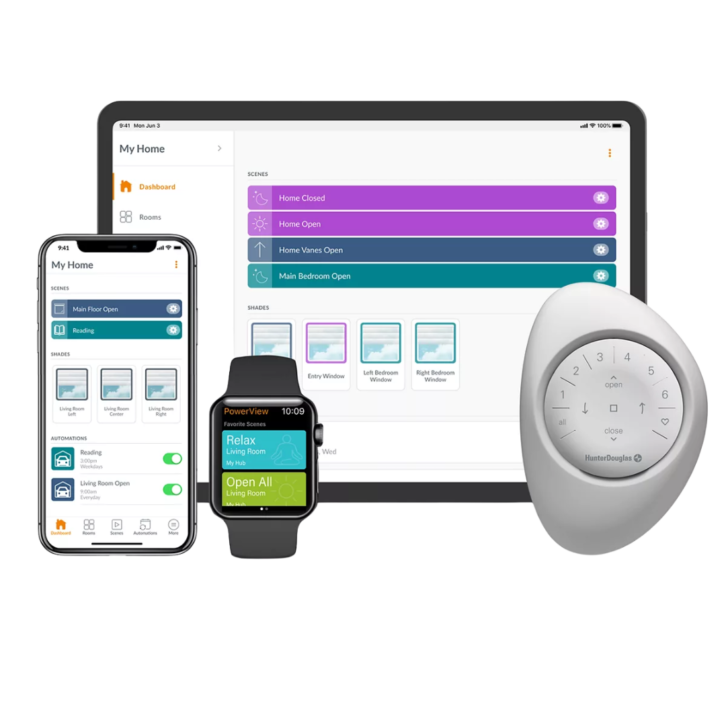
However, there are huge advantages to using a Gateway, and CI projects will likely include one or more on every project. For one, the Gateway sits on the network and mobile devices communicate with it via Wi-Fi, and it then communicates to the shades via a more powerful and optimized Bluetooth transmitter. This allows for range extending on large projects and synchronizes each shade daily to ensure they always move in sync with each other when Scenes or Automations trigger. The Gateway also delivers precise hembar alignment when there are more than four shades in a single room. Also, a Gateway is required for any automation integration. Finally, the Gateway allows the owner to fully access their system from anywhere through the app via RemoteConnect, giving complete control over the system just as if you were at home with no extra setup required.
The regular Gateway is Wi-Fi-only (both 2.4 and 5 GHz) and handles up to 15 shades, while the Pro has Ethernet, can power via PoE (and be ceiling mounted), and handles up to 30 shades. You can mix-and-match these on large projects as needed.
Gen 3 shades offer all the same power options as before, but with some cool, new upgrades. If the home is under construction, PowerView+ Gen 3 is the hardwired, premium power and control option, utilizing a new Smart Power Supply with a 4-wire cable for both power and communication to up to 16 shades. PowerView+ Gen 3 is currently available with Pirouette, Silhouette Quartette, Designer Screen Shades, and Designer Roller Shades. Beyond the most reliable control, PowerView+ Gen 3 shades contain ultra-quiet motors that measure around 32 dBA, up to twice as quiet as previous designs.
If pre-wiring isn’t possible, Hunter Douglas offers several other power options: local 18-volt DC power, a Battery Wand, a Satellite Battery Pack, a Rechargeable Battery Wand, and a new Internal Rechargeable Battery. Battery powering makes for simple installs, but also means finding a place to mount/install the pack that provides homeowner access. I loved the convenience of the rechargeable battery wand I had for my Gen 2 shades, as I could have spare batteries charged and ready to go, and the swap out was a breeze. However, with my outside-mount windows, there was no elegant way to conceal the battery wand and wire, meaning it just sat visible on top of the shade, diminishing the clean look.
The new Internal Rechargeable Battery solves this issue by concealing the battery within the shade’s headrail, providing a clean and seamless look at the window with nothing visible. It also allows for the smallest mounting depth for Hunter Douglas automated shades and is the quietest of all available battery options. Currently, this option is available with Designer Roller Shades, Designer Screen Shades, Alustra Architectural Shades, Alustra Woven Texture Roller Shades, and Designer Banded Shades, and requires a minimum 28-inch shade width.
The tradeoff is when it comes to charging, as you’ll now need to make a connection directly to the charging terminals inside the headrail on the right side of the shade. Hunter Douglas offers a variety of charging accessories allowing users to charge without needing a ladder, which I nicknamed “the fantabulous contraption.” One of these is the Magnetic Charging Adapter that kind of “snaps” the charging pins securely into place, making for an easy connection. Of course, while charging you’ll have a cable dangling down the wall, and unless you buy multiple chargers, this means doing one window at a time. Fortunately, battery life is approximately one year assuming two daily (one up, one down) cycles, so charging isn’t something you’ll have to deal with too frequently. Batteries can be recharged approximately 500 times.
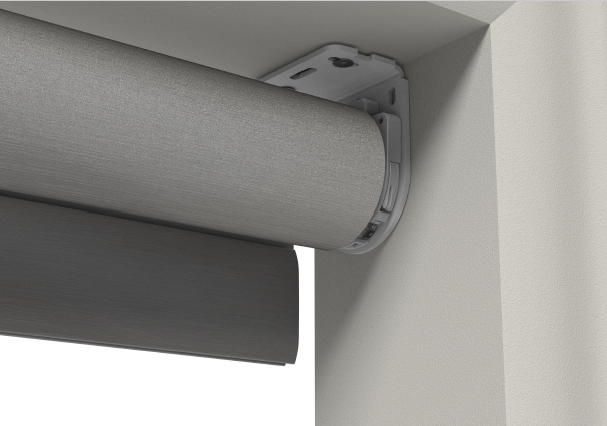
The new Gen 3 remote looks very similar to the old, though perhaps a bit sleeker. This allows you to operate six defined shade groups that can be single or multiple shades, plus all. There are also now two favorite presets for each group.
On the horizon is a new Scene Controller that will provide quick control of scenes created in the PowerView App. This is a single Decora size that can be nested in a tabletop holder or wall-mounted. With an E-ink display similar to a Kindle that shows up to three scenes at a time, this is a slick-looking device.
New PowerView App
The PowerView App has been redesigned to not only expedite setup time for the installer, but to deliver personalization, customization, and simplified control of shades from the convenience of any mobile device or tablet. With Gen 3, the entirety of the setup process is now performed via the PowerView App.
Hunter Douglas says that that setup time for an average shade project is just 15 minutes with Gen 3, down from around 45 minutes with Gen 2. Shades identify based on proximity via Bluetooth, letting you walk through rooms, quickly identifying each shade via a jog function, and then adding them to the project. To further speed up the install, the app includes many common pre-labeled rooms and shade names. Additionally, the system automatically creates two to three scenes based on shade types added to each room, such as all open, all closed, or privacy.
Modifying shade limits and adding remotes is also performed within the PowerView App, no longer using the button on the shade or remembering specific button sequences. The button on the shade headrail is now a control button, giving access within the app to advanced settings and controls such as Calibration, Factory Reset of the Shade, Shade Replacement, and Motor Replacement. This button can still be used to test shade operation and to start and stop shade movement and is required to initially “wake” internal rechargeable battery shades out of shipping mode.
There is a new installer setup feature that allows you to set up the system without needing any user passwords or access to the client’s device or Wi-Fi. At the end of the install, an email within the app transfers the system to the homeowner, and then gives them the option of inviting other users to have access. These invites can include Complete Access to do everything, or Basic, say for a guest, to just control shades and activate scenes but not edit home settings or accessories.
The app also provides loads of flexibility and customization for the homeowner, eliminating the need for any installer interaction to create scenes or automations, rename, or even reorder the layout.
The app is divided into five clearly defined sections: Dashboard, Rooms, Scenes, Schedules and More. The Dashboard is a customizable home page where you can favorite and order specific shades, scenes, or automations for easier/faster access to most-used commands. Rooms gives quick access to all rooms within the home with shades, letting you jump into that room and see/control all the individual shades as well as scenes. Scenes displays all shading scenes as well as giving the option to create new ones, with a variety of options for ordering the layout. Schedules trigger created scenes based on time of day using an astronomic timeclock and can be set to happen at specific times, or before/during/after sunrise/sunset, and these can be set to happen every day or just on specific days. These are created in a simple guided process that is easy enough for anyone to follow with little/no instruction. The More menu offers tools such as adding new shades/remotes, enabling integrations like Alexa, Google, or Apple Watch, checking firmware versions in devices, etc.
In the case of remodels, add-ons, or updates to the home, you might have projects where you’ll be adding new Gen 3 shades where there is an existing Gen 2 system. Fortunately, legacy and Gen 3 systems can exist in the same home within the same app, however the added functionality and capabilities in Gen 3 require a thin veil of separation from Gen 2. When registering the new system using the owner’s same email address, the system will recognize a registered Gen 2 Hub associated with the user account and will guide the user through the process of merging the two. After this is done, two persistent tabs are at the top of every page in the app, allowing users to switch between generations with a single tap. Different Scenes and Automations need to be created for each generation of PowerView in the Home, and a scene/automation created in one has no effect on the other.
Since I reinstalled several of my previous Gen 2 shades, it was a simple option of creating a new room in the Gen 2 section of the app, moving the old shades into that room, relabeling them, and then creating new scenes and automations for them. In practice, this was a simple, straightforward workaround that didn’t cause any issues or confusion, and switching between systems in the app is intuitive.
In Use
The shade design with the internal battery required using a new mounting bracket that I found not only easier to install and level, but which also makes it much easier to remove the shade if need be for any reason.
After setting up scenes in the PowerView app — Morning, Daytime, Sunset, and Goodnight — and adding timed automations to trigger them, the system just did its thing, requiring no further action on my part. The sheers and blackouts just opened and closed when I wanted, whether I was home or away.
One of my complaints with the previous system was the lack of any detailed feedback and control in the app. Instead it just displayed an approximation of the shade’s current position. Now you are given precise, real-time updates and display of each shade’s position with an adjustment slider or ability to enter a numeric percentage. This makes it easier and quicker to get your scenes to the exact desired location, say creating a nice architectural line across multiple windows.
Another real improvement is full remote system control via RemoteConnect (requires a Gateway). Now instead of just triggering a scene, you have complete control of your shades, scenes, and automations — even editing and creating new ones from anywhere, but the experience is the same as if you were inside the home.
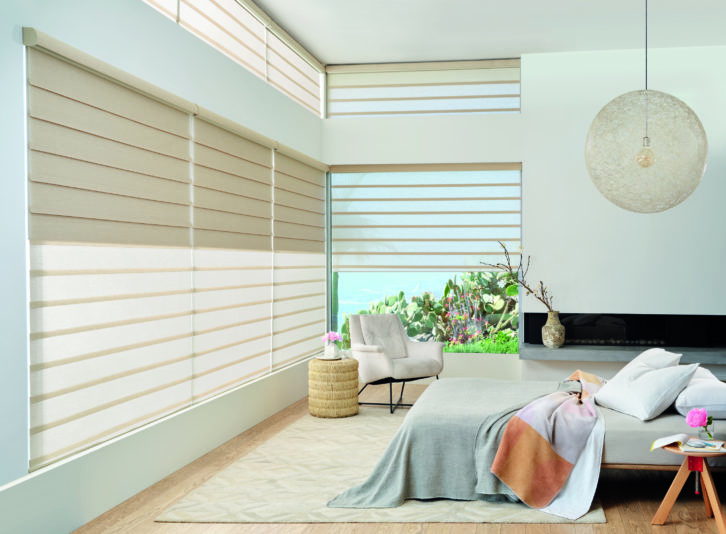
Tying the shades into my Control4 system was a simple process of adding and identifying the Gateway, then using the Sync Gateway and Add Shade and Scene Drivers commands to pull in all of the shade information and bindings. The entire process took less than 10 minutes. Once part of an automation system, you can then have the shades respond to other events like thermostat temperatures or entertainment scenes. Also cool was that with the Control4 shade scene, I could group shades from a variety of manufacturers — or even Gen 2 and Gen 3 shades — to all respond as one group. And whereas the previous integration would occasionally stop returning or updating correct shade position info, this was now always in sync and correct.
Another criticism I had about the old design was how loud they were when moving. This was partly a byproduct of the way the Duolite shades work, with the tube-inside-a-tube design creating an amplification chamber that increases the volume, but they were loud enough to be heard from another room and to wake us in the morning when operating. The Gen 3 models are now significantly — upward of 10 dB — quieter. Another nice touch is the option of engaging a new “Discreet” mode that runs scenes at half the usual speed, making them even quieter. I enabled Discreet for the initial morning scene in our bedroom where I’m most sensitive to the noise. The tradeoff is that Discreet mode drains the battery faster, but it’s great to have that option.
In my previous review I wrote, “Whether you’re new to automated shading or you’ve been installing them for years with another solution, there are two big reasons why you owe it to yourself to give the Hunter Douglas CIP program serious consideration: price and selection.” And with the new Gen 3 platform, to that you can add “performance.”
https://www.HunterDouglas.com; 800-789-0331
Product Specs:
- PowerView Gen 3 motorization available on 20 different shade styles
- Duolite shades offer both sheer and blackout fabrics on a single roller
- Power options include hardwiring to a 16-shade power panel, local DC power, battery wand, rechargeable battery pack, or internal rechargeable battery
- Control options include PowerView Remote, Scene Controller, PowerView app (iOS/Android); communicates to shades via Bluetooth Low Energy
- Gateway not required on small/single-room projects; Gateway Wi-Fi (both 2.4 and 5 GHz) only, handles up to 15 shades; Gateway Pro has Wi-Fi and PoE, handles up to 30 shades
- Supports third-party integration with Brilliant, Clare Controls, Control4, Crestron, Crestron Home, Elan, RTI, URC, and Savant; voice control via Amazon Alexa, Google Assistant, and Apple HomeKit
